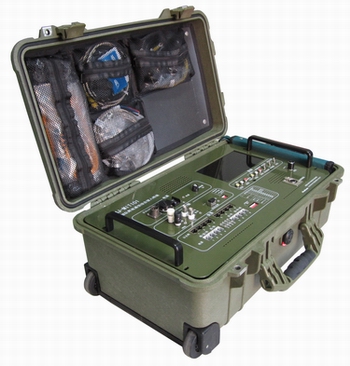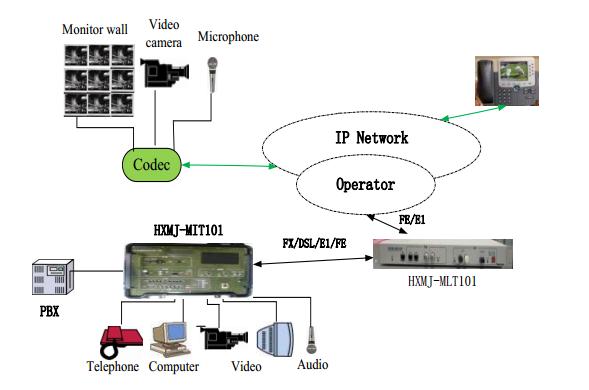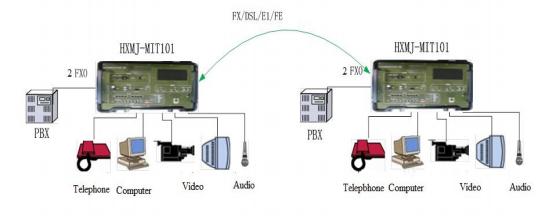Products Guide
HXMJ-MIT101

Product Overview
HXMJ-MIT101 is an integrated access terminal based on the next generation network (NGN),belongs to the terminal device of the NGN network access layer. The device can implement the telephone voice service (and fax service), data and video services communications on IP network by using different transmission media,and provides three kinds of remote interfaces Voice service can work with Asterisk, OpenSer and other standard SIP Server, and supports standard SIP,H.323 protocol.
HXMJ-MIT101 device has three transmission ports,they are 1 HDSL, 1 E1 and 1 optical Ethernet (FX). The device provides 8 analog voice ports to meet there quirements of on-site voice service, provides 8 Ethernet ports and 1 composite video broadcast signal (CVBS) port.
HXMJ-MIT101 device can be used for point-to-point connection, and can also interwork with soft-switch stored-program control exchange (SPC exchange) such as SOPHO-IS3000 in market to realize extension agent function. The device configuration management adopts Web Server to configure system or monitor the real-time operation status of device through Webpage browsing in the terminal computer.
Features
l Transmissionport:
Narrowband copper wire transmission: 1G.SHDSL port, comply with G.991.2 standard; 1 E1 port, meet ITU-T G .703recommendation;
Broadband transmission: 1 FX port; complywith IEEE 802.3 recommendation;
l Provide 1 bidirectional video access, adoptH.264 code, provide the picture in picture function, and support microphoneinput;
l Voice port supports 8 channels two-wirephones (FXS /CHP, or FXO(1st-2nd), or 2100Hz magnet (7th-8th)),provide 2 channels telephones for escaping when the power is off;
l Provide 8 10/100Base-T Ethernet ports (can beused as a transmission port or a network port);
l Rich alarm indicators, simple operation,using Ethernet port to monitor;
l Use WebServer to manage the operation of thedevice;
l Support subscribed pattern: point-to-pointinterconnection can be set through Dips instead of NM;
l Support the embedded software and firmwareonline upgrading and updating or the version back off;
l Support +12V DC/220V AC (Bimodal powersupply).
Technical Specifications
Item | Description | |
Type | Max Number | |
HDSL Port | 1 | User mode: Customer premises equipment (CPE)/ Central Office (CO) DSL working mode: Annex A mode DSL rate: In Adaptive mode, 192~2304 kbps Connector: Covered wire binding post |
E1 port | 1 | Bit rate:2.048 Mbps ±50ppm Line code:HDB3, comply with G.703 standard Connector: BNC Input Impedance:75Ω Frame format: Comply with ITU-T G.704, ITU-T G.706 Compression law: Comply with G.711 A law of ITU-T Power level:±2.37V±10% |
Ethernet Port | Electrical port:8 | Port mode: Electrical port: Ethernet MDI port, auto negotiation mode Optical port: auto negotiation mode Protocol: IEEE 802.3 Connector: Electrical port: RJ45 ,Optical port: SFP |
Optical port:1 | ||
Video Port | 1 channel of input:3 | Port mode: Composite signal Connector: RCA connector Video bit rate: 128K-15M bps PAL: 720×576, 704×576, 352×576, 352×288 NTSC: 720×480, 704×480, 352×480, 352×240 Video resolution: TS/TOPAV/VES flow Encoding class: ISO/IEC-14496-10/H.264 Baseline/Main/High Profile Frame bit rate: NTSC:30 frame/s, PAL: 25 frame/s Audio encoding method:AAC-LC,G.711,optical port: 1 Audio bit rate: 16K, 32K, 64K, 192K, 224K, 384K bps Audio mode: Mono |
1 channel of output:3 | ||
Voice Port and Signaling (traditional | Switching-side | Off-hook impedance: <500W On-hook impedance:10K |
User-side | Loop impedance: ≤2000Ω (including the phone) Free circuit voltage: ≤50V Loop current:25mA Off-hook threshold:8Ma Polarity reversion delay:<50ma> Dialing: Pulse dialing monopulse distortion 5ms The total distortion of in-band tone dialing meets the requirements of voice ports Off-hook delay:<100ms> | |
Ringing Current | FXS Ringing Current Generator | Frequency: 25Hz ± 3Hz Amplitude: 75V ± 5Vrms Ringing current delay:<50ms> Total output power: ≤3W (per chassis) |
FXO Ringing Current Detection | Amplitude range: 38Vrms (Minimum) | |
| Impedance | 600Ω or ternary impedance |
Audio range | 300~3400 Hz | |
Encoding law | G.711A law of ITU-T recommendation | |
2-wire port level | 2-wire Tx 0dBr ± 0.5dBr | |
2-wire Rx -3.5dBr ± 0.5dBr | ||
Return loss | 300-600Hz >12dB | |
600-3400Hz >15dB | ||
Frequency response | 300-3400Hz complying with ITU G.713 | |
Air noise | £-65dBm0p | |
Gain | -45dB~+3dB (Error less than ±0.5dB) | |
Total SNR | Comply with ITU G.713 | |
Carrier Magnet Port | Voice | Port level: 2-wireTx: 0dBr ± 0.5dBr 2-wire Rx: -3.5dBr ± 0.5dBr Other voice index: The same as common 2-wire audio |
Signaling | Signal detection: The minimum is 20Vrms Signaling mode: Analog 2100 Hz single-tone 2100 Hz signal generator: -6dBm0 ±1dB(Amplitude) 2100Hz ± 5Hz(Frequency) Signaling detection: No less than -17dBm(Amplitude) 2100Hz ± 50Hz(Frequency) | |
Clock | Clock source: Internal clock, Line clock | |
Chassis size | (H/D/W) | 229mm x 351mm x 559mm |
Working Environment | Operation temperature | -10°C ~ 50°C |
Storage temperature | -20°C ~ 65°C | |
Power | AC power supply | 176~264V AC (47 ~ 63Hz), 50/60Hz |
DC power supply | +12V (+9~+15V DC) | |
Consumption | ≤50W | |
Humidity | 0-90%RH (non-condensing) | |
Weight | 15kg | |
Typical Application

Application-1: Typical Application working with HXMJ-MLT101

Application-2: Point to Point Application

 Login
Login
 IP/MPLS/IPRAN
IP/MPLS/IPRAN Location:
Location:

 免费注册
免费注册



